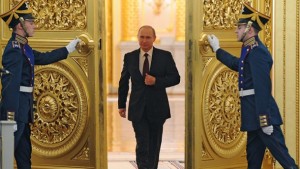 Russia is asserting itself in the world, challenging American policies in Eastern Europe and the Middle East. Russian troops helped annex the Crimea and are doing the same in the Eastern Ukraine. Russian aircraft and advisers recently deployed into Syria to strengthen its position in the Middle East. Cold War Two is underway.
Russia is asserting itself in the world, challenging American policies in Eastern Europe and the Middle East. Russian troops helped annex the Crimea and are doing the same in the Eastern Ukraine. Russian aircraft and advisers recently deployed into Syria to strengthen its position in the Middle East. Cold War Two is underway.
During Cold War One we greatly overstated the Soviet Union’s strength – and durability. Its economy was weaker than intelligence bureaus calculated, as were its military spending relative to GDP and the quality of its troops. Shortly after the Soviet Union collapsed, an American colonel toured Eastern Europe and was astounded by the backwardness he saw, and irked by the poor intelligence he’d based his professional life on. (See Andrew Bacevich, Washington Rules: America’s Path to Permanent War.)
The new Cold War will be long. But Russia today has as many serious problems as the Soviet Union did. We should recognize them as we proceed, in Syria and elsewhere, and not see Russia as an omnipotent adversary we must respond forcefully to around the world.
Islamic militancy within
The Soviet Union’s disintegration led to independence for several non-ethnically-Russian states along the empire’s western and southern periphery – the Baltic states, Belarus, the Ukraine; and “the ‘Stans” stretching from Turkmenistan to Kyrgyzstan. Nonetheless, Russia still contains millions of non-ethnic Russians.
Fifteen percent of the population is Muslim, concentrated in the Caucasus and Crimea, though found in other pockets owing to Soviet-era dispersal policies, especially during World War Two. Russia’s siding with the Shias of Syria and Iran is worsening matters.
Crimean Tatars live chiefly in recently annexed territory and while having no recent history of conflict, they resent falling once more under Moscow’s heavy hand.
Chechens and Dagestanis of the southern Caucasus wage intermittent guerrilla fights with Russia and have launched terrorist strikes in the region and in Moscow. The conflict is limited now owing to previous harsh retaliation and generous Moscow subsidies to obliging chieftains. Conflict is also limited because hundreds or even thousands of fighters are with ISIL and the al Nusrah Front in wars only a few hundred miles away. They will return, perhaps aided by Saudi incentives.
Islamic militancy without
Russia conquered its southern periphery over several centuries and lost it in the blink of an eye when the Soviet Union collapsed. The expanse from Turkmenistan to Kyrgyzstan was scene to Islamist fervor in the early twentieth century. Soviet commissars countered, imperfectly, by encouraging ethnic identities over a pan-Islamic one.
Since independence in 1991, the region has witnessed generous population growth and inadequate economic development. Ethnic groups fight over water and land. Young men go off to war in Af-Pak, Iraq, and Syria. Tajikistan’s security chief recently fled the country to join ISIL.
The countries are no longer parts of Russia. They are parts of its Near Abroad – areas once under Moscow’s direct control, with appreciable Russian populations, deemed within its security interests. An Islamist Central Asia would combine with the NATO forces in Eastern Europe to form a strategic concern from Tallinn in the north to Bishkek in the east. Grand visions of conquest and vengeance may build in Central Asia and attach to Chinese ambitions for the resource-rich area.
Longterm political problems
Putin rules his domain. He has subjugated the state and the economy as thoroughly as Romanov and Bolshevik predecessors did. The duma, a putative representative body, applauds his every deed. He is the state. But after him, what will come?
Succession problems recur in Russian history – after Ivan IV and Catherine II, after Lenin and Stalin. A ruler’s death often brought elite intrigue, assassination, and instability. Whomever Putin appoints one day will not have the benefit of defined procedures to ensure a smooth transition. Nor will he have the personal authority that Putin today wields over state and army, oligarchs and generals. He will only have the intentions of a fading or interred autocrat.
The economy
Russia has never been a land of bold entrepreneurs and private enterprises. The state has always led the way with investments and monopolies. The end of communism saw key economic assets fall into the hands of oligarchs after dubious transactions between state officials and cronies. Entrepreneurs see the long shadow of the state cast over them and their property. Many send their money out of the country as soon as possible, and hope to leave themselves.
The economy depends on oil and gas. Part of Putin’s popularity is based on the distribution of oil revenue during recent times of high prices. However, world demand is not rising as steeply as once thought, US production has skyrocketed, and new fields are coming on line across the world. Prices are expected to remain low for years.
Russian moves in the Crimea and Ukraine brought sanctions. Perhaps more importantly, European importers seek oil and gas supplies less tied to military adventures and free of arbitrary changes in price and supply. Israel and Egypt will soon export natural gas and are positioned near European markets. The US isn’t far behind.
Kurdistan’s oil already flows into Turkish pipelines then to Mediterranean terminals. The Saudis, angered by Russia’s Syrian intervention, are approaching Eastern European countries with offers of oil at discounted prices (and purchasing fewer arms from Moscow). Russia, then, is facing lower prices and shrinking market share – and at a time of bold, costly actions in the world.
©2015 Brian M Downing